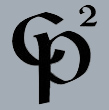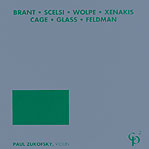This CD contains reissues of two different recording projects. My primary desire was to reissue CP26, an LP with music of Scelsi, Xenakis, and Glass, which constituted a combination-of-flavors I still enjoy. Obviously, 44 minutes of music is far too short for a CD (as an aside--is the public even aware of how the increase in available time on a CD, as opposed to an LP, and the expectation that that time will be filled, has made the already marginal "business" of releasing recordings of 20th century music ever more absurd?). Having re-acquired the tapes of my LP set "Music for a 20th Century Violinist," the idea of combining CP26 with some of the "20th Century Violinist" material was obvious, but which material? I did not wish to lose the contrasts within CP26. What could I choose that might even enhance those contrasts? Fortunately, "20th Century Violinist" contained four bon-bons, or should I say petit-fours, that I felt could both offset the larger pieces, and nevertheless preserve their identify. While deciding upon the order that best would embed the original three works, I began to sense relations among some that couldn't and shouldn't be present, but which I nevertheless found. It is my hope that this arrangement of these pieces will eventually appear to be as if intended from the very beginning.
Henry Brant's QUOMBEX (for [6 stringed] viola d'amore and music boxes) was written in 1960. It was inspired by Margaret Stark's sculpture "Bird with Passenger," which is "in the author's collection." The viola d'amore part consists only of the natural harmonics of the octave and of the twelfth, and the ascending strings are tuned: C (one octave below "middle" C), F#, B natural, F natural, B flat, and E. During the mix Brant insisted (to my then consternation) upon adding sounds that he just recently (1993) referred to as odds and ends. Unfortunately, neither of us can recall just what those odds and ends were.
ANAHIT (composed in 1965) is the ancient Egyptian name corresponding to Venus, and Giacinto Scelsi's work of this name is essentially a lyric poem for violin and small orchestra. The work is in one movement with two parts, joined by a short violin cadenza, the whole constituting a single unified musical gesture. Much of Scelsi's music explores the aural world of interference phenomena through the simultaneous use of various rates of vibrato and unison beats of a single tone. This interest led Scelsi to extensively work with scordatura - or retuned strings - thereby enabling him to obtain unisons over three contiguous strings. The scordatura for the solo violin part of ANAHIT is G, G, B, D.
Stefan Wolpe's SECOND PIECE FOR VIOLIN ALONE (composed in 1966) demonstrates his typical use of pitch rotation, beginning with a brusque presentation of a three-note motive (G, A, B) which is almost immediately transposed, intervallically altered, permuted and interposed with its original form. Octave displacement, other transpositions, and elision of forms are then used to further develop the motive, which is gradually transformed into the elegiac, lilting, eight-bar phrase that ends the piece. This SECOND PIECE FOR VIOLIN ALONE is by far my favorite Wolpe work, not the least because of its pith and vigor, as well as lack of verbosity. From my perspective today, the work also strikes me as being not dissimilar (in the overall gesture) to the next work on this CD (MIKKA by Xenakis), although the detail could hardly be more different. Also, the method of pitch manipulation is not all that different from what Glass describes in his notes to STRUNG OUT. It is perhaps worth noting, if only as an example of "autre temps, autre moeurs," that had I even thought either of these things in the seventies (when I recorded these works), I probably would have been shot.
MIKKA (dedicated to Mica Salabert) was written for and first performed at a party give by Mme. Francis Salabert in 1972; hence its title and brevity. By early 1975 enough people had asked Xenakis for a longer work for solo violin, and MIKKA "S," which "can be played alone or following MIKKA" was finished in November, 1975. Both works continue Xenakis' exploration of string glissandos, and are his first works for solo violin. MIKKA is in one section, and is monophonic. MIKKA "S" is in two sections - the first two-voiced, the latter, for single voice. Both works can be considered short virtuoso encores in the sense of the World's Favorite Glissando!
Cage's NOCTURNE for violin and piano was written in 1947. "In Nocturne an attempt is made to dissolve the difference between string and piano sounds though the convention of melody and accompaniment is maintained. The character of the piece is atmospheric and depends for its performance on a constant rubato and the sustaining of resonances." (John Cage)
Pianist: Gilbert Kalish (For other music of Cage on this label, see CP2103 with his CHORALS, CHEAP IMITATION, and FREEMAN ETUDES I-VIII.)
STRUNG OUT for amplified violin was written in the summer of 1967 and first performed at a concert at which all the music was presented physically in "shapes" suggested by the titles. The music for STRUNG OUT was printed in "accordion fold" style so that, when opened, it formed some twenty continuous pages strung together. It was set up on a series of music stands making an "L" shape on the stage. The violinist began playing on the short leg of the "L," walked down to the corner and out the long leg, taking in all about twenty minutes. In order to fix the sound to a stationary sound source while the performer moved, the violin was amplified by a pick-up attached to the bridge and the signal was conveyed via amp/preamp to two speakers on either side of the stage. My use of amplified sound began from this period and continues into the present.
Structurally the piece is, I think, self-revealing. At the outset, a first inversion triad is outlined. The upper three notes become a point of departure for a series of rhythmic devices. Notes are added one by one to the initial figure, finally producing continuous ascending and descending scales. At times the melodic figures are broken into smaller, discontinuous rhythmic fragments contrasting markedly with the more continuous scale passages. Repetitive structure, stable harmony, continuous eight note movement--all easily recognizable features of the music for amplified ensemble which followed--are present in this early piece. (Philip Glass)
Morton Feldman's VERTICAL THOUGHTS II dates from 1963, and is one of five VERTICAL THOUGHTS, all written in the same year, all for different instrumental combinations. Using as it does Feldman's early period temporal-notation (an amalgam of traditional note-values, space = time, and some written instructions) the VERTICAL THOUGHT rapidly acquires a problem of horizontal cohesion. It was this lack of control as to when events actually occurred that (in my opinion) drove Feldman to his later, and much more precise rhythmic notation. For further discussion of this issue, see my "open letter" to Morty which constitutes the notes to CP2101.
Pianist: Gilbert Kalish
(For other music of Feldman on this label, see CP2101 with FOR JOHN CAGE, and CP2102 with SPRING OF CHOSROES.)
PZ, May, 1995
| TRACK LISTING |
| |
| 1. Henry Brant: QUOMBEX |
(6:59) |
| 2. Giacinto Scelsi: ANAHIT |
(12:38) |
| 3. Stefan Wolpe: SECOND PIECE FOR VIOLIN ALONE |
(3:07) |
| 4. Iannis Xenakis: MIKKA |
(4:38) |
| 5. Iannis Xenakis: MIKKA "S" |
(4:55) |
| 6. John Cage: NOCTURNE |
(4:16) |
| 7. Philip Glass: STRUNG OUT |
(21:14) |
| 8. Morton Feldman: VERTICAL THOUGHTS II |
(4:59) |
| |
TOTAL TIME = 64:05
PAUL ZUKOFSKY, violin
|
1 Henry Brant (1913-) QUOMBEX
Publisher: Carl Fischer, Inc.
Recorded at Paul Hall, Juilliard School of Music, June 3, 1972
2 Giacinto Scelsi (1905-1988) ANAHIT
Publisher: G. Schirmer, Inc.
Recorded at the Oberlin Conservatory of Music, October 8, 1973
3 Stefan Wolpe (1902-1972) SECOND PIECE FOR VIOLIN ALONE
Publisher: Josef Marx
Recorded at Paul Hall, Juilliard School of Music, May 21, 1972
4 Iannis Xenakis (1922-) MIKKA
5 Iannis Xenakis (1922-) MIKKA "S"
Publisher: Editions Salabert
Recorded at Big Apple Recording Studio, New York City
June 29, 1976
6 John Cage (1912-1992) NOCTURNE
Publisher: C.F. Peters
Recorded at Paul Hall, Juilliard School of Music, May 21, 1972
7 Philip Glass (1937-) STRUNG OUT
Publisher: Dunvagen Music Publishers, Inc.
Recorded at Big Apple Recording Studio, New York City, June 29, 1976
8 Morton Feldman (1926-1987) VERTICAL THOUGHTS II
Publisher: C.F. Peters
Recorded at Paul Hall, Juilliard School of Music, May 21, 1972.
Library of Congress Card Catalog Numbers:
76-750640 (Scelsi)
76-750641 (Xenakis)
76-750642 (Glass)
CP2108
©1991 Musical Observations, Inc.
Warning: Copyright subsists in all recordings issued under this label.
|



